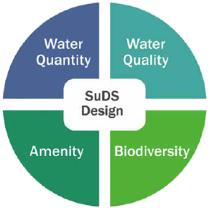 Issued: December 2016
Issued: December 2016
New climate change requirements also came into force on 1 December 2016.
Sustaining SuDS
Ironically, a key challenge with sustainable drainage systems (SuDS) is still the question of who adopts and maintains them after installation.
Schedule 3 of the Flood and Water Management Act, which proposed SuDS Approving Bodies (SABs) to approve and maintain SuDS, is yet to be implemented.
Adoption and maintenance of SuDS remains unclear.
Wales clears the air
The Welsh government has taken a number of positive steps to move things forward.
- The Wales SuDS Advisory Group has been re-convened.
- A research and consultation process will report back in early 2017 and is covering:
– the implementation of Schedule 3
– the costs and benefits of SuDS
– how to improve uptake in Wales
– evidence of the wider benefits, such as health and wellbeing. Less tangible benefits have often been ignored in past studies because of the difficulty in evaluating them. They are to be seen in the context of the Well-being of Future Generations (Wales) Act 2015, which aims to improve the social, economic, environmental and cultural wellbeing of Wales. - The Welsh government Standards and guidance for sustainable drainage serving new developments in Wales (January 2016) give statutory requirements should Schedule 3 be implemented.
Speaking with local authorities in Wales, the general preference is that the SAB approach is implemented, providing clarity to all stakeholders – subject to funding of course.
Hurdles remain, but Wales is moving towards clarity.
Allowing for climate change
The Welsh government has now confirmed new climate change requirements for planning in Wales.
The new requirements are based on the UKCP09 risk-based approach and have become more complex and onerous.
- The three river-basin districts of Wales (Severn, West Wales and Dee) each have different climate allowances.
- Each district has three key allowances (for low, medium and high emissions).
- The potential increase in river flows varies from 0% to 75%.
- Use of the central estimate of 20% to 30% is recommended in Flood Consequence Assessments (FCAs), while considering sensitivity to the upper-end estimate of 75%.
- A sea-level rise in Wales of 1,094 mm up to 2116 is reiterated.
What the new allowances mean for development
The increase in allowance for river flows from 20% to 30% in FCAs does not seem too significant in comparison to some areas of England. It means slightly higher levels of development in Wales.
The climate change allowances will also not affect the current flood zone C1 and C2 classifications under TAN15.
However, the recommendation to consider the upper-end estimates of up to 75% is unclear. How will it be interpreted in the planning process? There is room for ambiguity and variation in approach.